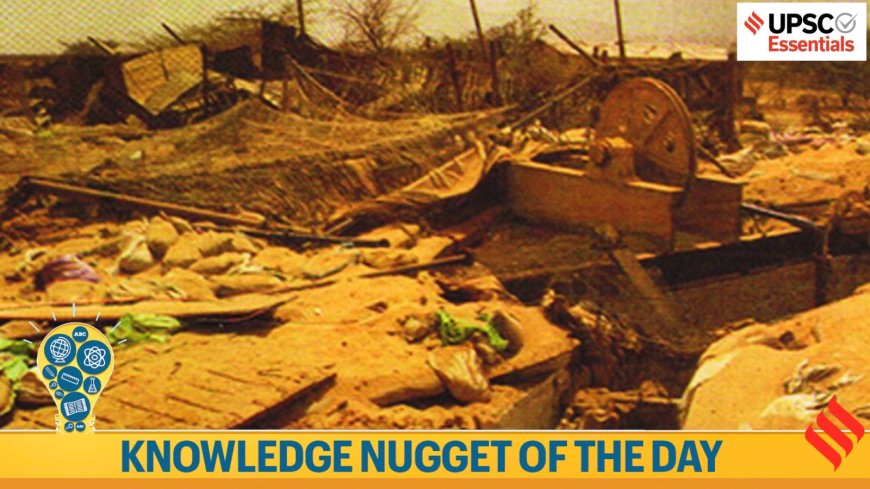Knowledge Nugget | National Technology Day: All you need to know about India’s nuclear might for UPSC exam

Knowledge Nugget | National Technology Day: All you need to know about India’s nuclear might for UPSC exam
Asarkari - Sarkari News, Jobs & Updates
By Priya Sharma
Introduction: Celebrating India's Technological Prowess
Every year on May 11th, India celebrates National Technology Day, a significant occasion that commemorates the nation's achievements in science and technology. This day is not just a tribute to our brilliant scientists and engineers but also a powerful reminder of India's journey towards self-reliance and its emergence as a formidable technological power. For aspirants preparing for the prestigious UPSC Civil Services Examination, understanding the nuances of this day, particularly its deep connection with India's nuclear capabilities, is paramount. This article delves into the history, significance, and various facets of India's nuclear might, crucial for your UPSC preparation.
The Historic Day: May 11th and Operation Shakti
The primary reason May 11th was chosen as National Technology Day is the successful execution of the Pokhran-II nuclear tests on this day in 1998. Codenamed 'Operation Shakti', these tests were a series of five nuclear explosions conducted at the Indian Army's Pokhran Test Range in Rajasthan. The first three detonations occurred on May 11th, including a 45-kiloton (kt) thermonuclear device (hydrogen bomb), a 15 kt fission device, and a 0.2 kt sub-kiloton device. Two more sub-kiloton nuclear devices were detonated on May 13th. This monumental achievement firmly established India as a nuclear weapons state.
The tests were a testament to the indigenous capabilities of Indian scientists and engineers, achieved amidst stringent international sanctions and technology denial regimes. The political leadership under then Prime Minister Atal Bihari Vajpayee demonstrated immense courage and conviction in authorizing these tests. Key figures who played pivotal roles included Dr. A.P.J. Abdul Kalam, then Scientific Adviser to the Defence Minister and DRDO Chief, and Dr. R. Chidambaram, then Chairman of the Atomic Energy Commission. Their collective efforts ensured the success of Operation Shakti, marking a watershed moment in India's strategic autonomy.
Tracing the Path: India's Journey to Nuclear Capability
India's nuclear journey began long before 1998, rooted in the vision of pioneers like Dr. Homi J. Bhabha, the architect of India's nuclear program. The first significant milestone was the Pokhran-I test, codenamed 'Smiling Buddha', conducted on May 18, 1974. India termed this a "Peaceful Nuclear Explosion" (PNE), emphasizing its commitment to using nuclear energy for peaceful purposes. However, the international community reacted sharply, leading to the formation of the Nuclear Suppliers Group (NSG) to restrict nuclear technology and material transfer to countries that had not signed the Non-Proliferation Treaty (NPT).
Despite these restrictions and technological embargoes, Indian scientists persevered. The period between 1974 and 1998 was marked by quiet, dedicated research and development, overcoming numerous challenges to build a credible nuclear deterrent. This journey underscores India's resilience and commitment to its national security interests. For UPSC aspirants, understanding this historical context is vital for appreciating the geopolitical implications of India's nuclear status.
Understanding India's Nuclear Doctrine: A Framework of Restraint and Credibility
Following the 1998 tests, India formally articulated its nuclear doctrine, which is characterized by responsibility and restraint. The core tenets of this doctrine include:
Credible Minimum Deterrence (CMD): India maintains a nuclear arsenal sufficient to deter a nuclear attack, but not for offensive purposes. The "minimum" is a dynamic concept, dependent on the strategic environment and threat perceptions.
No First Use (NFU): This is a cornerstone of India's policy. India pledges not to be the first to use nuclear weapons in a conflict. However, it reserves the right to retaliate with massive force if attacked with nuclear, biological, or chemical weapons on Indian territory or Indian forces anywhere.
Non-use against Non-Nuclear Weapon States: India will not use nuclear weapons against states that do not possess them or are not aligned with nuclear-weapon states.
Strict Political Control: The decision to use nuclear weapons rests solely with the civilian political leadership, exercised through the Nuclear Command Authority (NCA). The NCA comprises a Political Council, chaired by the Prime Minister, and an Executive Council, headed by the National Security Advisor.
Commitment to Disarmament: India continues to support global, verifiable, and non-discriminatory nuclear disarmament.
India's Nuclear Triad: Ensuring Deterrence
To ensure the credibility of its deterrent, India has been developing a robust nuclear triad – the ability to deliver nuclear weapons from land, air, and sea.
Land-based: This includes a range of ballistic missiles such as the Agni series (Agni-I, II, III, IV, V, with Agni-V being an Intercontinental Ballistic Missile - ICBM) and the shorter-range Prithvi missiles. These provide varied strike capabilities.
Air-based: The Indian Air Force operates aircraft like the Sukhoi Su-30MKI and Mirage 2000, which are capable of delivering nuclear warheads. This offers flexibility in deployment.
Sea-based: This is considered the most survivable leg of the triad. India has made significant strides with the induction of INS Arihant, its first indigenously built nuclear-powered ballistic missile submarine (SSBN). INS Arihant is capable of launching K-series Submarine Launched Ballistic Missiles (SLBMs) like the K-15 Sagarika and the under-development K-4. The development of more SSBNs and longer-range SLBMs is ongoing, enhancing India's second-strike capability.
Impact and Global Standing
The 1998 nuclear tests initially led to international condemnation and sanctions from several countries, including the United States. However, India's responsible nuclear stewardship, coupled with robust diplomatic efforts, gradually led to its acceptance as a de facto nuclear weapons state. A major breakthrough was the India-US Civil Nuclear Deal in 2008, which effectively ended India's nuclear isolation and allowed it to engage in international civil nuclear commerce. This has significantly boosted India's energy security plans. India's consistent advocacy for non-discriminatory disarmament and its impeccable non-proliferation record have further enhanced its global standing. For more updates on such crucial topics and government job notifications, visit https://asarkari.com.
Why This Matters for UPSC Aspirants: Connecting the Dots
For UPSC aspirants, National Technology Day and India's nuclear program are not just isolated events but interconnected themes with profound implications across various subjects:
GS Paper III (Science and Technology, Security): Questions on indigenous technological development, achievements of Indians in S&T, India's defence preparedness, nuclear policy, and the role of DRDO and ISRO are common.
GS Paper II (International Relations): India's nuclear status shapes its foreign policy, its relationships with major powers (P5 countries, especially the US and Russia), neighboring countries (China, Pakistan), and its role in international forums like the UN, NSG, MTCR, etc.
Essay Paper: Topics related to technology as a driver of change, national security imperatives, India's quest for strategic autonomy, or ethical dimensions of WMDs can be expected.
Conclusion: A Legacy of Innovation and Strength
National Technology Day serves as a potent reminder of India's scientific acumen, technological prowess, and unwavering commitment to national security and self-reliance. The journey from 'Smiling Buddha' to 'Operation Shakti' and beyond is a story of ambition, perseverance, and strategic foresight. For UPSC aspirants, delving deep into these developments is not merely about memorizing facts but about understanding the intricate interplay of science, policy, and international relations that shapes modern India. As future policymakers and administrators, a nuanced appreciation of India's technological achievements and strategic capabilities is indispensable.
Kam sabdo me kahein to, National Technology Day, celebrated on May 11th, marks India's 1998 nuclear tests, showcasing its scientific prowess and strategic autonomy, a vital topic for UPSC aspirants covering science, security, and international relations.
Team Asarkari
Keywords
National Technology Day, India nuclear program, Pokhran II, UPSC Science and Technology, India nuclear doctrine, Operation Shakti, APJ Abdul Kalam, nuclear tests India, India's nuclear weapons, credible minimum deterrence, No First Use policy, UPSC current affairs, Indian defence technology, Homi Bhabha, nuclear triad India, Agni missile, INS ArihantWhat's Your Reaction?
 Like
0
Like
0
 Dislike
0
Dislike
0
 Love
0
Love
0
 Funny
0
Funny
0
 Angry
0
Angry
0
 Sad
0
Sad
0
 Wow
0
Wow
0










































